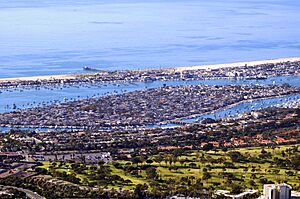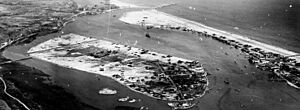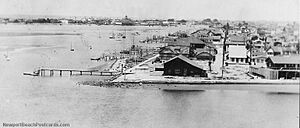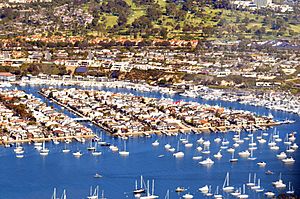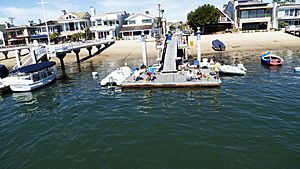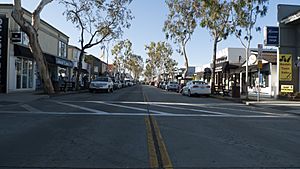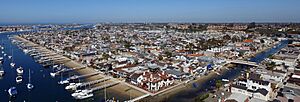Balboa Island, Newport Beach facts for kids
Balboa Island is a lovely community located in Newport Beach, California. It's like a special island neighborhood right by the harbor! You can get there by a bridge, a ferry, or by using public docks for boats. The whole community has a paved walkway around it, perfect for walking and enjoying the views.
On Balboa Island, you'll find Marine Avenue, which is a lively street with small shops. There are restaurants, bakeries, places to buy fishing gear, and stores selling local crafts. The island also has its own fire station and a post office.
Contents
What is Balboa Island Like?
The Balboa Island community is made up of three islands that were actually created by people! These are Balboa Island (the biggest one), Little Balboa Island (to the east, connected by a bridge), and Collins Isle (the smallest, to the northwest, also connected by a bridge).
- Balboa Island: 33°36′23″N 117°53′40″W / 33.60639°N 117.89444°W
- Little Balboa Island: 33°36′23″N 117°53′16″W / 33.60639°N 117.88778°W
- Collins Isle: 33°36′31″N 117°54′1″W / 33.60861°N 117.90028°W
Balboa Island is connected to the mainland by a short bridge. There's also a special ferry service called the Balboa Island Ferry. It uses three small boats to carry cars and people across the harbor to the Balboa Peninsula.
How Was Balboa Island Created?
Originally, Balboa Island was just a muddy area surrounded by swamps. The beautiful Newport Harbor we see today was made by digging up millions of tons of mud and dirt.
Early Days of Newport Harbor
In the late 1860s, two brothers, James and Robert McFadden, bought a large piece of land. This land included what would become Newport Beach, part of the Balboa Peninsula, and the muddy areas that later became Balboa Island. They started selling off parts of their land.
They built a successful fishing pier on the Balboa Peninsula. In the 1870s, ships used the bay to load goods like animal hides and hay. Captain Samuel S. Dunnells brought a steamer into the bay and set up "Newport Landing" with a small dock.
The McFadden brothers took over the landing in 1875. For almost 20 years, they ran a busy shipping business. However, the bay wasn't a true harbor yet. Sand bars and a dangerous entrance made them move their shipping business to the oceanfront. They built a large pier on the sand spit that became the Balboa Peninsula. This spot was great because a deep underwater canyon, carved by an old river, made the waters calm near the shore.
McFadden Wharf was finished in 1888 and connected to Santa Ana by train in 1891. This area became a busy shipping center. But in 1899, the government decided to improve a new harbor at San Pedro, which became Southern California's main port. The McFadden Wharf and railroad were sold, ending Newport Bay's time as a big shipping center.
In 1902, James McFadden sold all his Newport property. This included the Newport town, half of the Balboa Peninsula, and the swampy lands that would become Balboa, Lido, and Harbor Islands. He sold them to William Stepp Collins and C. A. Hanson.
Building the Island by Dredging (1906-1941)
Collins and Hanson saw that Newport Bay could be a great place for vacations and fun. They partnered with Henry E. Huntington, who owned the Pacific Electric railway system. Huntington used his "Red Cars" to help new communities grow outside of Los Angeles. By 1905, the Red Cars reached Newport, bringing thousands of visitors from Los Angeles.
Collins built a special machine called a dredge. Starting in 1906, this dredge began digging a channel on the north side of the bay. It piled the sand and mud onto the tidelands, creating what would become Balboa Island.
Between 1902 and 1907, many waterfront areas in Newport Beach were divided into lots. This created the small lots and narrow streets that you still see today. Real estate sellers started promoting Balboa Island in cities like Pasadena and Los Angeles. Many early island residents had family in Pasadena because of this.
In 1908 and 1909, Collins moved his dredge to a muddy area called "Snipe Island." He dug a channel and piled up sand and mud, and that's how Balboa Island was truly born!
Collins advertised Balboa Island across the country. He offered small lots for $600 and waterfront lots for $750. He even used a brochure with a fancy hotel that didn't exist yet to help sell the lots! He promised ferry service, electricity, paved streets, and water. However, some lots were sold for as little as $25.
Early owners faced challenges like bad roads, weak sidewalks, and homes that flooded during high tides. By 1911, many people left the island because of these problems. But Collins didn't give up. In 1914, he held a big Fourth of July celebration. Thousands came to enjoy races, tours, and parades. Lots started selling again, and Collins sold 700 lots, making Balboa Island a popular place to live and visit.
The island grew slowly at first. In 1916, it became part of the City of Newport Beach. In 1918, the Balboa Island Improvement Association was formed. This group worked with the city to improve things like the seawall, ferry service, sewers, water, and paved streets.
In 1919, water for the island came from a "Wooden Water Tower." In 1920, Park Avenue was the only paved road. People used outhouses because there was no sewer system. Later, gas service came to the island for heating and cooking.
The Balboa Island Ferry
Joseph Beek was a student who loved the area. He became one of Collins' salesmen. Joe Beek was very important in developing Balboa Island. In 1919, he got the first contract for a ferry between the island and the Balboa Peninsula. In 1920, the first car was pushed across the bay for 10 cents!
In 1922, Joe Beek got a 15-year agreement for the ferry. He used a boat called "Joker" that could carry two cars. Today, the ferry service still runs with three boats named "Admiral," "Captain," and "Commodore." Each can carry three vehicles. Joe Beek later became an important state official until he passed away in 1968.
By 1921, homes were filling up the island. Roads to the area were still not very good, so many people arrived by train and took the ferry. The first bridge from the mainland to the island was built in 1912. It couldn't carry cars until it was improved in 1929.
The seawall was rebuilt in 1922. The Grand Canal walkway was rebuilt in concrete in 1929. The current seawall, walkways, and public piers were finished in 1938.
In 1924, the narrow wooden bridge to Balboa Island was replaced with a wider wooden one. In 1928, this bridge was taken down for a concrete bridge. Some wood from the old bridge was used to build a restaurant on Marine Avenue. The new concrete bridge built in 1929 lasted for 51 years. In 1981, a new, modern concrete bridge was built with wide walkways. The island's population grew from about 100 people in 1929 to around 4,500 in winter and nearly 10,000 in summer!
Jamboree Road (1953)
The 1953 National Scout Jamboree was a huge event for the Boy Scouts of America. It took place where Newport Center and Fashion Island are today. This was the first time this big event was held west of the Mississippi River. About 50,000 scouts from all over the world attended!
Thousands of tents were set up in an area that could only be reached by a muddy road called Palisades Road. After the event, the road was paved. Later, its name was changed to Jamboree Road to honor the Boy Scout event. It's still a major road in Newport Beach and ends at Balboa Island.
Balboa Island Today
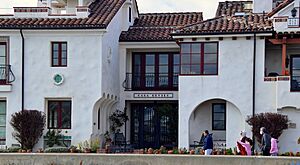
Balboa Island celebrated its 100th birthday in 2016 with a parade!
Balboa Island is a very busy place. About 3,000 people live on a small area of just 0.2 square miles (0.5 square kilometers). This means there are many people living close together, even more than in San Francisco! Even though homes here are very expensive, most of them are on small lots, usually 30 feet by 85 feet.
The edge of the island along the bay has many piers where homeowners can dock their boats. Marine Avenue and Agate Avenue are the main streets with shops and businesses.
Balboa Island has several groups that help the community:
- The Balboa Island Improvement Association: A group of people who live or work on the island.
- The Business Improvement District: A group of merchants on Marine Avenue.
- The Little Balboa Island Association: A group for homeowners only on Little Balboa Island.
These groups offer many ways for people to get involved in the community.
Balboa Island is known for having some of the most expensive homes in North America. A two-bedroom house with a water view might cost around $3 million. New homes can sell for $4 million, and waterfront homes can range from $3.5 million to $9 million.
The only bar on Balboa Island, called the Village Inn (or "VI" by locals), has been there for over 80 years.
Balboa Island in Movies and TV
Balboa Island has been featured in several movies and TV shows:
- The 1949 film The Reckless Moment is mostly set on Balboa Island.
- In the 1958 musical The Girl Most Likely, the main character lives on Balboa Island and takes the ferry to work.
- The TV show Arrested Development is partly set on Balboa Island. The family's famous frozen banana stand is located there.
- In the Netflix series Dirty John, two characters rent a waterfront home on Balboa Island.
- In the video game Raft, players travel to Balboa Island to find materials and weapons.
Famous People Who Lived Here
- Buddy Ebsen — an actor and dancer
- J. Warren Kerrigan — an early silent movie star
- John Vallely — a retired basketball player
See also
 In Spanish: Isla Balboa para niños
In Spanish: Isla Balboa para niños


